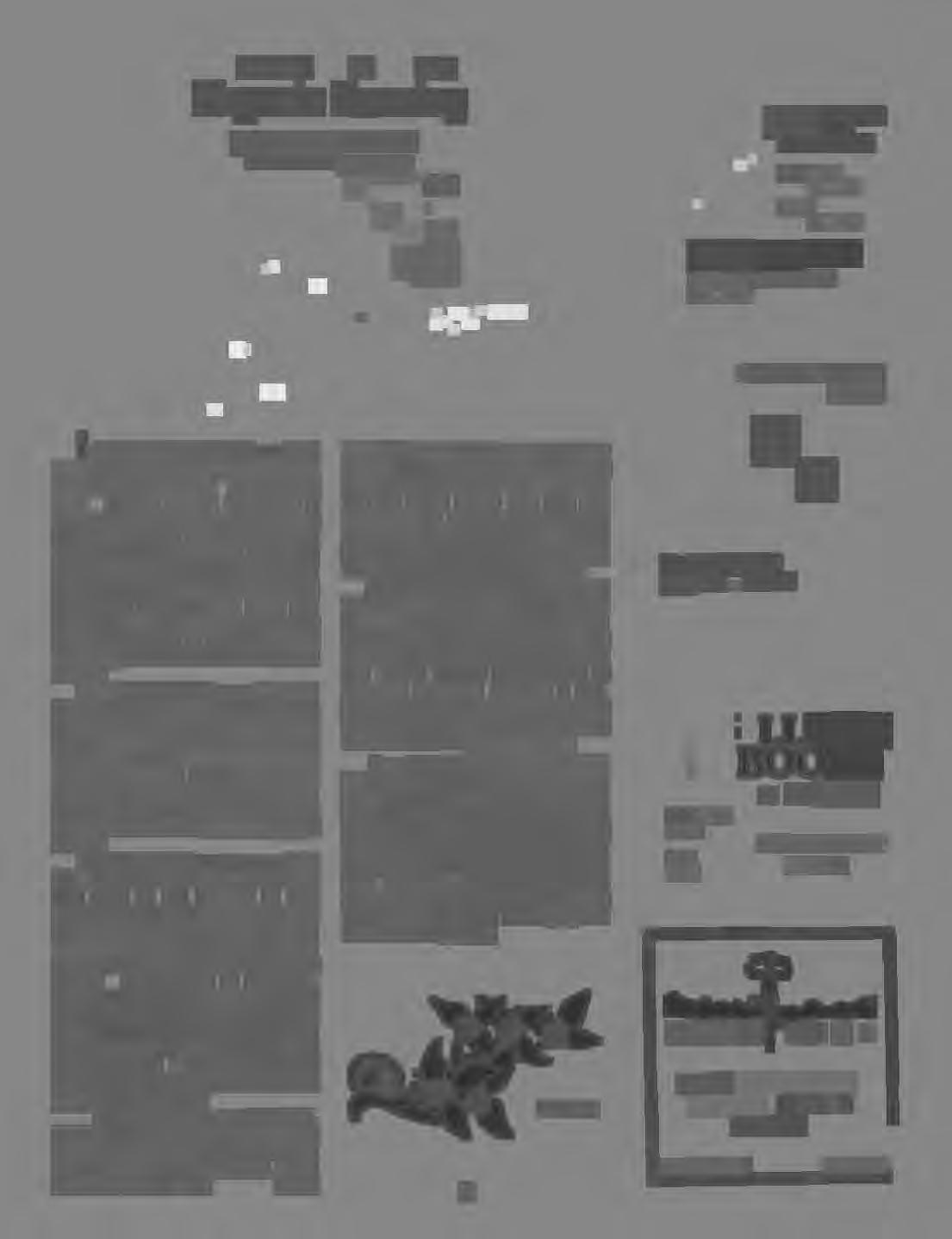Mon~bly Planet
In this issue: Special Section: The Hunger Chain: Business, Technology and Food Organic Farming (p. 7 ), Agribusiness (p. 5 ), Appropriate fishing technology (p. 6 ), Food Co-0ps Face the Eighties (p. 8 ).
Also: Hanfod Revisited (p. 4 ), Cleaner Energy (p 12), The Adopt- A- Beach Program (p. 3 ), Responsibility, is it American? (p 14& 15), Fairhaven Reborn (P10) and MORE.

4 ilson Library Archives
volume VII number 5 June1986
A Publication of the Associated Students Environmental Center , Western Washington University
Editor: Miriam Ellard
~: Al Arkills, Randall Brower, John Brown, Craig Day, Michael Kane, Robin Mortimer, Colleen Majors, John Pavitt, Mary Pearsal, Kimberly Peterson, Mellissa Rosaaen, Susanne Stevens, James Zirk.
Artists: David Taylor, Mary Pearsal, Robin Mortimer, Michael Kane, Bethany Shipley.
Layout: Staff Advertising Manager: Bethany Shipley Advisor: Lynn Robbins
Special Thanks to: Our contributors, the staffs of the A.S. Print Shop, and the Computer Center in Miller Hall for all their patience, the staff of the A.S. Environmental Center: Jan Wangen, Bill McCord, Ilene Anderson, David Taylor, Denise Ackert, Steve Walker, Allison Carpenter, and Sam Card, and finally, our advertisers for their support.
THE MONTHLY PLANET is published twice a quarter by the Associated Students Environmental Center. We strive to inform, entertain and stimulate thought on environmental issues. We do not aim to be free of opinion, only to print any opinion. The opinions expressed herein are not necessarily those of the A.S., the Environmental Center or our advertisers.
YOU CAN PARTICIPATE !!
You are most welcome to submit letters-to-the-editor, articles, poetry. Your comments and critique are eagerly awaited.
LOOK FOR OUR NEXT ISSUE IN THE FALL 111111111111111111111111111
And don't forget to sign up for the Monthly Planet Seminar in the fall - one of the last classes were you can get credit for expressing your real opinions!
The Editor is resisting the urge to write the traditional, teary, goodby-and-thank-you letter in this last issue under her editorship. Thanks any way you all know who you are.
LOVE, MIRIAM
Thoughts of a Commuser
 By Al Arkills
By Al Arkills
What is a com muser? Well, the term problems, to relax with a good stereo, to describes a person who muses as he or enjoy the panorama of town and country, she cruises; your typical everyday and observe the nature of humans as commuter. Commusers come from every drivers just to name a few. It can be a walk of life and muse about almost time to set aside for yourself something anything. Being a commuser and a Huxley most of us could use but do not often get. student, I tend to muse about all of the Even with high miles-per-gallon world's problems and how they might be automobiles, commusers must have some solved and summarized in the few short guilt pangs about energy use and weeks of each quarter. Forty-six years pollution. On the other hand, we can ago, I commused while attending Eastern rationalize that maintaining a single Washington School of Education, residence during the school quarter may now known as Eastern Washington partially or totally offset this problem. University. Perhaps some commusers With the opening on EXPO '86, 1-5 have been around longer then the displays a string of out-of-state automobile!! automobiles, trucks, and recreational
I live in Marysville, just north of vehicles, whose owners must have Everett, which means I must commute114 forgotten the oil and gasoline shortages of miles each day to school. There are the recent past. students and instructors at WWU who Now, pressure is again mounting to travel even further. When asked if this is raise the highway speed limit. Domestic difficult, I must answer, "yes and no." If and foreign car manufacturers are caught you dwell on the distance and the trials of up in a horse power and performance race driving, it is difficult. If you muse on other that contradicts recent efforts to raise matters as you cruise, the distance gasoline milage. As a contribution to seems to shorten and the entire greater milage, more efficiently designed experience becomes one of time. In my engines are being produced. Drivers case, the commuting time averages a little negate both improvements by increasing over one hour each way. This is the same their speeds and failing to reduce speeds amount of time and fuel that I spent in strong headwinds. Obviously, without before retirement, driving only half the changes in human attitudes, technology distance, as I went to and from work in cannot provide all the answers. heavy urban traffic. Lately, it is on such issues that I muse. Commusing provides necessary time to organize your thoughts, to consider
P A ET STA FF :
Lt=:~! ? -, :__~ - L~ - l .,c1/' I \f ! _.__,___/ ' ,,,, --v ,J, ---.. 2
Nurture Nature Adopt a Beach
By Craig Day
Recently, after a large oil tanker spill occurred off of Port Angeles, Washington, scores of Port Angeles' citizens, along with other concerned groups, volunteered their time and efforts in an attempt to save the numerous Puget Sound waterfowl whose feathers had been fouled. Many people went to great efforts to collect the oil-soaked birds, wash, and release them. As a result, a large percentage of the birds lived, despite the damage to them.
This incident, and peoples' reaction to it, illustrates the great concern that many Washingtonians have for Puget Sound and its shorelines. But, one doesn't have to wait for an ecological tragedy such as the Port Angeles tanker mishap to become involved with efforts to care for and protect Puget Sound and its beaches.
The Seattle Aquarium now sponsors the Adopt-A-Beach program under a grant from the Environmental Protection Agency. Adopt-a-Beach is a community-based program in which individuals and groups learn about a beach, shoreline, marsh, or estuary while caring for it. The program includes a series of workshops and fieldtrips that instruct you about local beaches. Then you are put to work on a project of your own selection or with help from the program. The Adopt-a-Beach program not only provides technical assistance and training through workshops, written
material, and fieldtrips, but also small grants for materials are available to groups with specific goals, projects, and plans.
Adopters of beaches are able to obtain help on projects covering a wide variety of areas which can include:
- Enhancing beach habitats
- Monitoring shorelines for pollution or misuse
- Wildlife inventories

- Collection of shellfish for study
-Development of educational materials
These are but a few of the activities possible under the Adopt-A-Beach program. This program is a way for any concerned citizen to play an important role in monitoring, cleaning up, and preserving Puget Sound.
The Adopt-A-Beach program is a way to demonstrate concern for the integrity of Pudget Sound, its aquatic life, and its ecosystems now, instead of waiting for the next tanker tragedy.
For further information contact· Ken Pritchard or Laurie Usher at 625-4358 or write: The Seattle Aquarium Pier 59, Waterfront Park
' Seattle, WA 98101
r.-.-.'·:···:
., /9 ... ' , ... ·:
. '
... ~ )\~l11 3 PACKS PACKS PACKS CUSTOMIZED PACKS A D SOFT GOODS FOR WILDER ESS , TOW A D TRAVEL 733-5608 We're in Old Fairhaven! FINE PRINTING 7))-19)5 Brealdut Lunch Snaclu Esp res so / Gelo to 131 QRa il road .\ , ~ Bd lt n ham , WA ll/121 ; F re,h Basel• Daily 1\11 Var1et1e Open Sunday 1, -676 -'> 2 AKASHA METAPHYSICAL BOOKSTORE • New age tapes, records and videos * Imported incense • Crystals - Jew1ery • Health posters - Cards • Lectures - Counseling 1124STATE 671 - 6153 Mon-Sat 11- 6 Sun 11 -5
Hanford Revisited Not Just an Ordinary Hometown
It is hard to avoid my past sometimes, especially when the region where I grew up is constantly in the news, and a subject in my classes.
Hanford was born in the secrecy of the Manhattan Project to produce plutonium for atomic bombs. Only a handful of the 51,000 workers who came to Hanford in 1943 understood the scope of the project. Work began in March 1943, building three reactors, three plutonium processing plants, fuel fabrication facilities, 64 underground waste storage tanks, and 4,300 homes for the workers. During that time the Hanford "camp" was the fourth largest city in Washington. In July, 1945, plutonium from Hanford was used in the first nuclear detonation at Alamogordo, N.M. On August 9th, 1945, Hanford produced plutonium was used in the bomb dropped on Nagasaki, Japan. Work at the Hanford Area had helped push the world into the nuclear age.
In 1947 the Atomic Energy Commission was established to manage the nation's nuclear complex. The Cold War was on, and the U.S. government demanded more plutonium for defense purposes. During the next eight years Hanford underwent a major expansion. About 28,000 workers built five more plutonium production reactors, two more plants for spent fuel reprocessing, and 81 additional underground waste storage tanks. Between 1959 and 1963, the N-Reactor was built, at a cost of $195 million. Unlike the earlier eight reactors whose sole purpose was to produce plutonium, the NReactor also produced steam to generate electricity. In the period from 1963 to 1966 the Washington Public Power Supply System (WPPSS) built a facility generating 860 megawatts adjacent to N -Reactor. Since 1966 this combination has produced more than 50 billion kilowatt hours of electricity.
In the summer of 1965 my family moved from Seattle to Richland. At this time, the first of the eight defense reactors were being shutdown. To offset the impact of the reactor shutdowns on the local economy, a plan called "Contract Segmentation and Diversification" was developed. General Electric Co. withdrew as sole contractor and operations were segmented into a number of different functions: reactors, laboratories, chemical processing, and support services. New contractors were required to invest private capital in the community to aid economic development.
By James Zirk

It was the economic growth in the community that had brought my father to Richland. Both my parents would eventually end up working for Hanford contractors. My father for Rockwell as a electrician, and my Mother as a secretary for Exxon Nuclear, which came to Hanford to produce commercial reactor fuels and to do research
During my childhood I didn't know very much about the Hanford Area. To my friends and me, it was an expanse of desert dotted with blocky grey reactors and research facilities where most everyone's parents worked. As I grew up, so did Richland. When I first arrived the city had a population of about 12,000. By the time I left to go to college, in 1980, Richland had a population of over 40,000. New buildings and businesses sprang up almost overnight. Government contracts at Hanford amounted to billions of dollars during the 70's.
Due to the construction of three W.P.P.S S. reactors, growth in Richland and the Hanford Area peaked in the late 70's. At this time I was attending school at Hanford High School, a new school which was built in north Richland. The highschool mixed kids from rural West Richland with the kids of scientists and corporate managers. It illustrated the two main livelihoods in the region, nuclear technology and agriculture. During those years new people were moving into town from all over the country, and Richland was alive with the energy of well paid construction workers.
The last time I lived in Richland was during the winter and spring of 1983-84, after three years at W.W.U. All my friends were gone, and thousands had left town when the bottom fell out of the WPPSS project. Only one of the WPPSS reactors was ever built, and 7 billion dollars of municipal bonds defaulted. Richland and the Tri-Cities area had been hit hard by the WPPSS disaster. Unemployment was high, roughly 20-30% of the housing was for sale, and many businesses closed.
In the early spring of 1984, I worked as a fuels operator for United Nuclear Co. I went through a lengthy physical at the Hanford Environmental Health Foundation and a week of orientation and safety classes to work in the Area. For two months I joined the other 14,000 workers in the Hanford Area. Security and radition monitoring were strict; it was part of the job. My job consisted of moving and taking inventory of spent fuel rods from
N-Reactor. Shielded by a pool of water 30-40 feet in depth, I used extended hoists and pneumatic thongs to move the canisters of fuel rods. I learned to undress from my protective clothing without touching its exterior surface. In just my shorts, I waited to be checked by a geiger counter after exiting from a radiation zone.
The job was interesting and it paid well, but the moral implications began to bother me. The spent fuel went on to the PUREX (Plutonium Uranium Extraction) plant were the plutonium and uranium were separated and shipped on to be used in the U.S.'s nuclear arsenal.
Richland is an oddity in an agrarian region. It has the authoritative, segmented atmosphere of a government camp. Gray government cars and numerous buses drive along four laned streets that funnel thousands of workers to their specialized site in the area. The economy of the area is based on the nuclear industry, and thus the majority of the people are very pro-nuclear. The local bowling alley is called Atomic Lanes. The high school's emblem is a mushroom cloud and they are called the Richland Bombers. In this atmosphere, I grew up with a very slanted view of the nuclear industry.
In the two years that I've been back in Bellingham I've learned a lot about the implications of nuclear arms proliferation and the commercial nuclear industry. I've been involved with WashPIRG and Whatcom County Nuclear Freeze, and have viewed the nuclear industry from the totally opposite end of the spectrum.
It is enough madness to have approximately 50,000 nuclear weapons in this world, but still N-Reactor and PUREX are producing more weapons grade plutonium and more waste all the time in the name of national security, of course. Thousands of curies of radiation were released from Hanford in the name of national security, and information was withheld from the public for 40 years. How much of the nation's environment do we have to sacrifice before we redefine national security?
Hanford is a potential site for the nation's first commercial nuclear waste repository. Richland is receptive but this issue is not just Richlands. We are all in this together even if the waste is not put in our backyard.
4 ________________.
Agribusiness Hungry for Profit
Ienjoy eating food, and I think most people like to eat. Fortunately I am in the position to eat most things I want (thanks to the generosities of financial aid) as long as they are in the same catagory of Top Ramen and macaroni and cheese. The problem of how to feed the world's growing population is, however, unresolved. Presently, an additional 212,000 persons are added to this earth every day. At this rate, it would only take about thirteen months to replace the 86 million soldiers and civilians who died in this century's wars. The population of the world is presently 4.8 billion.
All of these people must be fed. Some, such as Kenneth Mueller, President of the Agribusiness Council (1985), say "Agribusiness is the solution that the world is looking for." So what is agribusiness and who does it serve? Agribusiness describes all activities from the seed to the mouth it feeds; this includes everything that happens on the farm, to processing and marketing, distribution, to the final consumer.
Agribusiness is an economic system in which large corporations work closely with international banks and Third World governments. It has helped to produce more food (through technologically intensive farming) yet at the same time produces more hunger
WAIT A MINUTE! If this system is working as it should, in theory, hunger would be reduced. Let 's take a closer look at agribusiness practices in Third World nations.
Small farmers, who have worked their land sometimes for several generations are being bought or coerced off their land. These small farmers and their families no longer have a source of livelihood. Large companies, such as Dole and Del Monte use the land to raise food or products for export.
Excerpt from Hungry For Profit (PBS Documentary) Peasant Farmer (Philipines, 1984 - through interpreter)
"My land was planted before In corn, coconuts, and rice. But two days ago, with no warning, the bulldozers showed up. It seems the government owns the land. We have no paper to prove It's mine. So now there Is nothing. We will Just die here. We have no more source of livelihood. Now a big company (Dole) will come plant pineapples on my land."
Generally, the displaced farmers can work as seasonal day laborers for a wage that sometimes amounts to the equivalent of three U S. dollars per day. Others migrate to ci1ies, becoming sq~~tters, looking for wor< that isn't there. M1ll10~~ of people are in this same position; the ~ItIes simply do not have enough work available for these displaced people.
And what about the food that Is produced? Agribusiness people seek profits. They want to grow food as cheaply as they can and sell the food_ on the global malket at the highest possible price. The result is feeding a few people very well with resources that will not go to millions of pecple who need them. Land that was previously used for the sustenance of small farmers is now used for export and those who work it are grossly underpaid.
Agribusiness practices result in s~me very serious social and ecological consequences. Lands that were used for traditional staple crops for a country are replanted with marketable export cr~ps. This means prces of the staple crop rise, increasing the strain on the economy. In Brazil fertile land is being used to grow sugar' cane to make an alcoho~ substitute for gasoline. This land isn't being used to feed the 20 mHion people who, because of a ten year lorg drought, were fore~~ to leave their farms and migrate to the cItIes. Some of these people eat donated food, others eat what they can find in the local garbage dump. .
Excerpt from Hungry For Prof 1t (PBS Documertary)
Interviewer: How old are your children?
Farmer: (through Interpreter): This one Is ten, this one Is one, this one Is four.

Interviewer: What did they eat for breakfast?
By Robin Mortimer
Agribusiness practices can da~~ge the environment. Two thirds of the ong1~al rain and cloud forests of Central Ame_nc~ have been cleared. This land re~lly isn t suitable for cattle grazing or agriculture and after a few years such practices must be abandoned because the soil will not produce. A country will suffer because the artifical revenue will not last for long. The people will suffer because of the environmental damage.
In the Sahel region of West Af~1ca critics claim that hunger is increasing because people are losing the means of growing their own food. The people of Sahel, who once were cattle herders and farmers living in environmental balance, have been displaced by Europe's call f~r peanuts. Peanuts deplete the ~011, harvesting uproots the plants, and winds carry off the loose soil. Thus the p_ean~t harvest diminishes and cattle grazing '~ less feasible. Herders then move their cattle to the desert fringe areas wh~re grazing turns grassland into expanding desert. This removes small peanut farmer's source of natural fertilize~. and they're too poor to buy chemical fert1lr_ze_r. So they grow peanuts until the soil is depleted then move elsewhere.
Why do governments allow this social and environmental injustice? Some countries are financially strapped a nd want to earn more foreign exchange (~o repay debts) by exporting goods. This short term gain is the main goal. In so~e situations, where a country is deeply in debt from borrowing when interest rates were low (and thus they borrowed beyond their means) the International Money Fund (IMF) will lend more mo~ey t? that country. Money is only lent 1f stringent austerity measures are met to free up funds to repay back debts. One such austerity measure is to export foods even if it means increasing hunger among the people of the country. Some gove_rnments welcome agribusiness corporations for their own personal profit.
Perhaps it would be better if agribusiness left the T~i~d World countries. As concerned 1nd1vIduals, we need to realize that foreign policy must be based on a sense of social justice. The Third World countries (free of foreign
Farmer: (through Tea with he1bs also. intervention) need to provide for their own
Interviewer: What Is the future of your children?
Farmer: (through Interpreter): The future of my children? I'm waiting to see the hour when they will die of hunger.
-Interpreter): people. Farmers can return to the land t~ produce for themselves and for their country. Export practices may look good on paper but they do not solve the hunger problem within the country. Dole pineapples sure are tasty, but are they worth the social and environmental costs?
SAIL POWER FOR THIRD WORLD FISHING COMMUNITIES
By Michael Kane
The Final Trawl
"Been three Jong years since we made her pay

Haul Away, my Jaddie-O And we can't get by on the subsidy Haul Away my Jaddie'O "
Gordon Bok
Coastlines across the world are inhabited by people whose main source of sustenance has come from the sea for thousands of years. Though the means of fishing vary with culture, locality, and technology, the result is the same. Seafood is an excellent source of protien and even though it is not as abundant as it once was, it is still an important part of many diets.
Following World War 11, oil availability increased and the price dropped, encouraging underdeveloped countries to began adopting diesel and gasoline engines to power their fishing fleets. Before the switch to petroleum-dependent vessels, wind and human power aided people in their hunting and fishing. Power boats depended less on wind and tides to get to the fishing spots while providing greater speed than sailboats. However, since the oil-price hikes of the late '?O's, the glory days of oil dependency have proved to be less than glorious. Rising fuel costs, engine parts scarcity, and the loss of traditional boat-building woods from deforestation left Third World fishing fleets stranded. As oil prices increased in the '?O's, renewable resources gained attention as an alternative to fossil-fuel dependency. ··
Research into development of sail power for commercial fishing and merchant vessels has been undertaken by various institutions, shipping companies, and private individuals. Aerodynamic and hydrodynamic advances in technology, coupled with high oil prices have made commercial sailing vessels economically feasible. Ocean Arks International was founded in 1981 by the New Alchemy Institute as a means of bringing back commercial sail.
The Ocean Pickup Project resulted from their interest in designing a vessel as fast or faster than a motor-powered boat to give coastal people of Third World countries an alternative to modern fishing vessels. With the help of James Brown and Dick Newick, a designer of racing multi-hulls, ( many of which hold transoceanic records ), a technique called Constant Camber was used to build the first Ocean Pickup, the "Edith Muma". The 32' long "Edith Muma" is a gaff-rigged trimaran with a one ton carrying capacity.
T echno1og1cal developments in building materials, blended with the Constant Camber technique made it possible to build hulls using molds, local fast-growing softwoods and epoxy. The designers of the Ocean Pickup were consciously developing a building technique that would rely mainly on local resources, be relatively inexpensive, and which the local fishing community could easily learn. The "Edith Muma" worked in Guyana, South America as a gill-net boat and a relay vessel for shrimp boats. She has enjoyed a successful career and to my knowledge, is still there.
By designing a vessel that could be built by the community with local resources, Ocean Arks International is promoting the empowerment of Third World peoples with the necessary skills to manage their resources in a sustainable way and still provide for themselves. This is a good example of appropriate technology and reflects the New Alchemy Institutes biological approach to design. With this type of technology, we will move to a less oil-dependant society, be better prepared to feed the world and renew our connections with the world ecosystem.
The "Edith Muma"
6
'
Lessons from China Organic Farming
By Kimberley Peterson
In America, farming is done on a large scale, with help from machines, chemicals and scientific research. Many people think organic farming represents a regression in agricultural research. This is not true, however. Organic farming is using the latest technology, applied to current research, to better maintain and manage a good quality of soil. Organic farmers do not believe in using any chemicals in their farming proccesses. They believe that in order to remain productive the soil must be cared for not abused.
During the last 40-50 years American farmers have been relying more and more on chemical fertilizers and pesticides that cause damage to soil and wildlife. As a result many acres of farmland in America have been ruined. Now compare this situation to China's: there the land has been farmed for over 4,000 years, and the soil remains fertile and productive. Why is this so?
The best possible answer comes from F.H. King's work in the early 1900's. King was chief of the Division of Soil Management at the U.S. Department of Agriculture and author of four books on agriculture. In 1906 and 1907 Dr. King traveled to the Orient and made the most careful observations of Japanese, Korean, and Chinese agriculture that had been recorded by an American up to that time. He was most impressed by the careful handling of organic materials by all Oriental farmers a direct contrast to the wasteful and destructive methods of many American farmers.
The Oriental systems, said King, produced a permanent, highly productive system of agriculture, with little erosion and a small need for fertilizer. While American farmers had already ruined

much land during King's time, the Oriental farmers were still growing rice and other crops on land that had been in continual use for 4,000 years, and was still productive. Dr. King's book which tells about his travels and studies is called Farmers of Forty Centuries, it is still being used by teachers and scientists today.
What preserves the Chinese soil is the careful handling of organic matter. This is a major aspect of farming that is being stressed by organic farmers today. For example, the soil is enriched with animal and human manure as oppossed to synthetic fertilizers. Perhaps if U.S. farmers would practice organic farming, as the Chinese have done, the life and quality of the soil would be greatly improved.
If you want to support organic farming, the best way to do this is to buy organic foods. Most of the fruits and vegetables that one would buy at Safeway or other grocery stores has been grown on large farms where chemicals have been used throughout the growth proccess of the food. Organically grown food can be purchased in Bellingham at the Community Food Co-op on State street just five blocks north of campus.
~ --
7 LARGEST SELECTION Of YARN & NEEDLECRAFT MON SAT 10 5 : 30 TUES \:..::=~-...-::::l~~./ 10 - 7 00 VJbuje l{am:PlluA 1200 13th FAIRHAVEN 676 - 1330 1140 North State Street 733-4927 A great place to goof off or eat. MON- AT 10-10 UN 10-6 ILLAGE BOOKS ~(J{df~ 1210 ELEVENTH ST 671-2626
Food Co-operatives Struggle to Meet The Eighties Challenge
By Susanne Stevens
Day to day decisions are deferred to the managers from the elected decision making body; the co-operative board. This would be fine if the managers were trained in making decisions for co-operatives, but they are not. As a result, a distance grows between the decision makers and the paying co-operative members; membership control declines.
2t~1 ~~_/7Jf!~

Since the 1930's, food co-operatives have been a economic alternative to traditional businesses. There are about 5,000 consumer food co-operatives in the nation today. They range in size from a few people getting together to buy in bulk at wholesale prices, to the large supermarket-like operations. Out of the $275 billion-a-year grocery business, food co-operatives account for only about $1 billion in sales annually. Food co-operatives have traditionally emphasized quality, natural foods, and politically wise purchases (i.e. boycotting grapes because of the United Farm Workers strike). Today, co-operatives are having trouble supporting their own growth with management, accountability, and competition.
Food co-operatives used to have a monopoly on the distribution of natural foods. The fitness craze and co-operative success of the ?O's and S0's made the large chain supermarkets take notice. Now "good-for-you" foods can be found everywhere. Co-operatives lost whatever competitive edge they might have had. They can not keep up with the economies of scale of the large distributors. The larger distributors are able to under cut co-operative prices. In response to this, co-operativies are taking one of two positions.
Some food co-operatives are choosing
to be anti-business. They are ignoring market indicators. These co-operatives are keeping their prices the same and staying away from traditional business methods of competition (i.e. advertizing). These co-operatives are failing apart. With an average after-tax profit margin of only one percent; rising rent, utilities, and labor costs are driving them out of business. Customers are unwilling to partronize food co-operatives when they can buy the same products for a cheaper price at a chain store. By keeping their prices high, these co-operatives are defeating therir purpose: keeping prices low and the quality of the product high for their members. Also, by not actively recruiting new members, co-operatives do not have the advantage of a stable influx of buying members.
Other food co-operatives are orienting themselves toward traditional business practices. Generally, those co-operatives are larger and have attained some market success. These co-operatives do not have the supportive hierarchies to see them through. They have never had professionally trained management. So they are actively recruiting managers from the traditional business pool. These managers try to exercise traditional business methods. A problem arises because co-operatives are not traditional type businesses. They have different goals, needs, and pressures.
The decisions made by the business managers determine which direction the business will go. Will the co-operative sell any product regardless of content or quality? Will flamboyant marketing schemes be used to bring in new nondiscriminating members? Putting unlimited control into the hands of hired managers and away from elected board members leaves the average member without a means to communicate views on the direction the food co-operative should take. The big question becomes how can this estrangement be avoided?
Not all food co-operatives have to fall into market ignorance or decreasing membership control. They can survive by using traditional business techniques wisely. They need to try to keep the integrity of what a food co-operative essentially is: quality products at low prices for the members. Good business practices can be compatible with good democratic decision making. Co-operatives exist because of the good will of the patron members. They should not be pushed into an unnatural entity of their own.
8
Make Grain Not War A Report on the World Game
In my younger days I played many board games, and a lot of them were militaristic in nature. A game my friends and I often played was called Risk, and was played on a vague map of the world. Players would move armies against each other vying to take over the world. Pacts and alliances were made and broken between friends, and players developed a destructive competitiveness.
On Saturday, May 10th, I played a game on the largest and most accurate map of the Earth. We used different strategies to achieve a totally different objective: to end world hunger. The game, called World Game, is the creation of Buckminister Fuller, and was brought to WWU by the Associated Students Productions, and the Center For Global Peace and Education. Approximately a hundred players from Western Washington and British Columbia attended the nine hour workshop, which was divided into three sessions.
The morning session oriented people to a macro perspective of the world, its resources and thier distribution, its possible destruction and possible positive future. The map of the world was 40 x 70 feet in area, and was located in Carver Gym. The average person in scale was 2000 miles tall, and the orbit of the space shuttle is at ankle height. The average person's foot is 300 miles long, and when walking they are travelling at 2 1/2 millions miles per hour. From this scale, you could see the earth as a whole, and relationships between countries become visible.
A hundred people became living scorecards each one representing 50 million people. Each person had a packet which contained information about the country or reoion they represented. We collectively tallied the World's distribution of population, food and energy production and comsumption, literacy levels, and military expenditures. As an illiterate person in India, ' I was crowded with the majority of the players in Asia. Communication was difficult between players, and it was cramped and uncomfortable. It symbolized the real world; I looked out at the players stretched out leisurely in the United States.
The next segment in the morning session was an exercise in diplomacy called Foxfire. Four players from India were chosen to represent the population of Pakistan. The hypothetical situation was that Pakistan had developed nuclear weapons and threatened to test them on India. Each country or region was given a packet of different diplomatic options, and we had thirty minutes, ten minutes representing a day, to resolve the crisis. As the minutes went by, people
By James Zirk '
and diverse ideals. The process itself was an exercise in workinQ with people and problem solving. Our group had great difficulty in focusing on a specific strategy, but developed a general theme of education.
In the evening session the eight groups presented their strategiE!s to the other groups and a panel of judges. I was surprised to find that education was the theme of most the strategies presented. Some of the more interesting ideas, were a world food bank, replacing weapons shipments with food, and playing the World Game on T.V. One group had a chain letter which people would send to the leaders of the U.S., U.S.S.R., and the U.N. Hopefully this would result in the distribution of thousands or millions of letters. The motto of this group was "think globally and act globally."
played roles of ambassadors and decision This statement was the theme of the makers. We tried frantically to communicate World Game. The game's purpose is to give within our groups and with other countries. In people a macr~ perspective of the world, and the end Pakistan annouced a 30 day work on pos1t1ve_ ways to solve ~orld moratorium on the testing of the nuclear probl~ms: Hunger 1~ the world has rec1eved weapons and peaceful negotiations were to attention in the media, and many groups and be held i~ China organizations have approached the problem.
The rest of the morning session we looked But still, how many times in a year does the at two extreme futures. The world's arsenal average U.S. citizen think about hunger be it of nuclear warheads is around S0,000. In the in Africa or in Bellingham? Each year 40 mapscale the average nuclear explosion is million people die from hunger and hunger the size of a bingo chip. With loud rumblings related dieases. This figure is equivalent to from speakers people dumped scattered more than 300 Jumbo jet crashes a day with 50,000 symbolic atomic blasts across the no survivors, almost half of the passengers land masses of the world. It was a grim being childern. display to see the world saturated in red Some people see humanity escaping the plastic chips. People stood in a silent awe for problems of the Earth in large spaceships. awhile, but later we cleaned the Earth of We already are in a huge beautiful nuclear weapons. Most nuclear warheads spaceship, a bright blue marble in the infinite have a life of about twenty years before they t~e~ec~:~en~: :~~i::i need to be replaced. It's possible to rid the as one species on one living planet. the earth of nuclear weapons within our life time, if humanity works together as a whole.
"Africa is We ended the morning session with a full of lonely peasants, millions of people positive attitude. We were asked to say what alienated from one another by the qualities a utopia on earth would have. P I ·h d t f 'd h' h destruction of nature.... Lamentation eop e a a vane y o I eas, w Ic were listed on a blackboard but after ten or fifteen alone does not provide enough ms,ght of the minutes people ran out of ideas. This always predicament of the lonely peasants. When happens at the World Game workshops. nature recedes, so do the prospects for thier What's important about this is that our well being • Those threads that tie t~e desired future is not too large or complex to p~asan!s to nature are too deep-rooted: th,er percieve. The greatest threat to a peaceful disruption leaves. severe ~ounds on the future is the inability of people to percieve it. health and collective cons~1ous~ess o~ the They fall into the trap of pessimism. We can people. The lonely peasa_nt is a gnm re"!mder not hope to achieve a better life without ~o t~e :est of human,ty of .. the ultimate taking the first step. 1mpl1cat1ons of a lonely planet.
In the afternoon and evening sessions,
Calestous Juma we divided into eight groups. During the Kenyanjoumalist afternoon session we worked within our groups on strategies to end hunger in the world. We had limited time and information,

"Fairhaven's Own" An Historic Town Comes Alive
W hat is it about the district of Fairhaven that entices people? Those that sense the spirit of this town are captured by the century old brick buildings, the unmistakeable charm and the friendly character of the citizenry. In recent years, a handful of entrepeneurs, merchants, and civic groups have dusted off the old shelves and opened their doors, feeding new life into the downtown area and setting the stage for an economic regeneration. It has been a piecemeal revival, yet it potentially links the not so distant past to a successful future. The attitude of Fairhaven has been to slowly but surely pick themselves up by the seat of their pants and attempt to create community interest, allowing Fairhaven's own unique and distinct identity to surface.
In the 40's, Fairhaven was a self-contained community with two grocery stores, a hardware store, an ice cream parlor, five gas stations, a Boys and Girls Club, a car repair service, and the pharmacy. The pharmacy is a landmark, still a successful business after 97 years.
Another landmark, sorely missed, is the elegant Fairhaven Hotel. After a fire in '53, the city government decided, in the name of urban renewal, to begin their "urban removal." The building is now lost.
Following a period of decline, the town again began to stir with new vitality in the early ?O's. The grandeur of the Marketplace building drew many visitors, especially Canadians, into the area. But the restored Marketplace's "boutique mentality" was a failure. The owner of the Marketplace, Ken Imus, says, "I had overestimated the seriousness of undercapitalized and inexperienced shop owners." These business people were confronted with high rent and forced to survive in an underdeveloped, economically depressed area. Walls of litigation and the devaluation of the Canadian dollar, among other reasons, caused the demise of the Marketplace. Its adjoining structure is now decrepid and its many businesses have either relocated or closed.
Today, an encouraged community hopes to breathe new life into Fairhaven's downtown, aking active interest in the town's historic significance and developing unified marketing strategies. This time there are success stories. One example of a successful business is the unique Hayden's Thriftway, initially the
By Mary Pearsall
main draw to downtown. Tony's Coffees draws a broad spectrum of clients from university students to upscaled yuppies, perhaps paving the way for a future University District. Two small, integrated theaters have served as a community "rallying" force. Village Books has become a popular island of retreat from the every day confinements of suburbia and antiseptic chain stores. The resurrected Fairhaven Restaurant, Dos Padres, Bullies and Dirty Dan Harris have also played vital roles in the transformation of the central business district.
Opposing the growth of such populist, pedestrian scaled buildings essential to a ~ -· ;
development plan. Their alternatives include a hotel, convention center, retail facilities and a marina. The corporation favors this concept, because it is close to the freeway and would be the first waterfront hotel in the area of Bellingham. Heedless of local public opinion, the Port Commission is willing to lease this land to the highest bidder.
Rather than bring in outside developers, one City Councilman, Tip Johnson, states "It's feasible to integrate industrial commercial waterfront business with the small business person." He feels that several of the vacant lots along the waterfront have good shop / store potential. The end results would link the two cities of Bellingham and Fairhaven and provide employment.
Such a vital spark could generate the economic success of downtown Fairhaven. The area is surrounded by 20,000 residents. The neighborhoods of Chuckanut Drive, Sehome Hill, and Edgemore have affluent residents. There have been sixteen new inq~ries for store space during the past three months. According Ken Imus, owner of several buildings in Fairhaven, "each of them are well established businesses working within the area and are making requests to relocate in Fairhaven."
Block

town are obstacles which could change the whole framework of what this community is trying to shape. Inspectors reinterpreting building codes and underestimating the inherent structural values of these older buildings have hindered the delicate restoration process.
Certainly, there is a need for wheelchair access units and earthquake proof reinforced steel additions. But the city's government, having its own interests, has put stumbling blocks in the path of the restorationists who are willing to save small parts of this older district, even without the support of tax dollars. The verbal support of city politicians and community input are needed to spur a new confidence in downtown innovation.
Port Commission proposals for the development of the eight acres between Maritime Contractors Inc. and Chris Craft suggest an industrial and commercial waterfront. The commission's plans were geared toward industries requiring deep water ports. This idea has now given way to a Canadian corporation's waterfront
The potential for ground floor shops is exemplified by the resurrection of the old Post Office. It now houses Great Stuff and The Glasserie. There is speculation about other ground floor possibilities; one new building could go in next to the old Post Office, its architecture keeping with the area's historic character. Other possibilities include cooperatively leased space on the ground floor of the Waldron Building. This would allow a group of people to design a part of their environment themselves.
Fairhaven is finally in a position to start showing its true colors. Flourishing populist feelings make it clear that the new frontier has close ties with the past. Together, people can create a town which is alive and vibrant, peaceful and relaxed; a town as beautiful as any town in history. With that goal instead of the "get rich quick" attitude in mind, it may be possible to enjoy a quality of life rarely found today near the crowded highways of our urban civilization.
1-W . r I~ •
There is no National Public Radio station in Bellingham. In fact, this corner of Northwest Washington is one region of only a few in the nation that does not receive National Publ ic Radio When the community is ready and the effort is made , it won't be long unt il a broadcast will be heard. Facing technical and financial obstacles to establishing a Public Radio Station in Bellingham, is a determined and prepared group of people who invision an alternative to radio programming.
National Public Radio (NPR) was formed in 1970 to provide noncommercial educational broadcasting to the public. Nationally, two thirds of the funding comes from federal, state, and local taxes. The remaining third comes from membership subscribers. Usually these non-prof it stations are located on the reserved 20% portion of the FM band (88 -92 MHz).
Bellingham has not had a public radio station for several reasons. Difficulty in obtaining financing, barriers of being located between two large cities, and declaring an unused frequency are some of the primary obstacles. Also, there has been very little effort made by anyone to pursue such a task, at least not until recently.
Since 1984, a group of dedicated local citizens have organized and volunteered their time to create Northern Sound Public Radio (NSPR). Gale Thompson, the secretary of the Board of Directors and Grant Administrator of NSPR predicts the station could air as soon as mid 1987.
Much effort has been made and many of the obstacles have been overcome. One unexpected problem has been difficulty in obtaining a location on the dial. All unused frequencies in this area are Canadian owned. However, negotiations are in process for temporary and subsequently, permanent usage of Canadian air waves.
Stay Tuned Public Radio in

Bellingham
By Colleen Majors
Another major task has been writing grant proposals to get the program go ing. So far the U.S. Department of Commerce has subsidized $4,000 planning grant. This grant paid for a engineer to assess and report on technical aspects of setting up a station here. The grant also paid for a Wahington, D.C. lawyer to assess the legal aspects . These results, in turn, were used to apply for additional financial aid.
There are several specific conditions required in establishing a station. Other than a location on the dial, qualified personnel and equipment, transmitting capacities, and listening audience specifications, the organization is requ ired to raise matching funds of $50,000 from private sources.
If NSPR can raise $50,000, U.S. Department of Commerce will match it with 75% of the cost to establish a radio facility The estimated cost is $150,000. NSPR is now dev ising ways to raise the $50,000 in this region. Along with membership dues, NSPR hopes to get much of its support from institutions, businesses , and corporations. The fund raising campaign will include on air and off air fund drives, auctions, and program sponsorship.
Once the station is established, it will be privately funded. The federal matching fund program's yearly requirement is beyond reach for a small station like Bellingham's. Thompson said "What we are planning to do is fairly unique; operating without any government money." NSPR will need to raise $50,000 to $70,000 a year to run the facility.
NSPR plans to locate the station in the Bellingham Towers Building on Commercial Street. The goal is to reach 250,000 people in 6 counties: Whatcom, Skagit, Island, San Juan, Jefferson, and Clallam.
The preliminary proceedure to establish the station here in Bellingham is to set up a transmitter on King Mountain, 11
near K-Mart. This would allow NSPR to "boost" the already existing NPR station in Seattle, KUOW, to listeners here in the north. Thompson says KUOW is expanding their news coverage and public service announcements to include Northern Puget Sound "in ant icipat ion of serving the new audience."
The new audience will be able to listen to such national favorites as "A Prairie Home Companion", a folk music and variety show; and "All Things Considered", a news and public affairs show. Public radio music usually includes classical, jazz, and ethnic.
Eventually, NSPR will have 25% local programming as well as direct programming from NPR. Local programming will make available a platform for local citizens to view and hear various issues of concern. Traditionally, public radio encourages political and social involvement with its listeners. After all , public radio is the public's station. It offers a feasible alternative to conventional radio programming.
When questioned about the affects NSPR may have on KUGS, Western Washington University's noncommercial radio station, Thompson said she felt there would be no competition. The two stations may even be able to share opportunities in training and programming possiblities. NSPR will cater to a different type of audience and will be broadcasting to a much larger region
In addition to all this activity, Northern Sound Public Radio and KUGS-FM are co-sponsoring the 1986 national convention of the National Federation of Community Broadcasters (NFCB). The conference will be held July 20-24 at Western Washington University. More than seventy different workshops will be offered. If you would like more information regarding NSPR or the conference, contact NSPR at 671-1912.
.:_· ·>: ·.: __:,<:·.\.\.:·: __··,.\:.··__·.::,·:.·:· ·_::·-<·::.:-·:~:.:> ·:·.~· .:\..·.. ·-·-:.,-<: _': .... ·. . _\ ·:· .· >.· ... ·.·
·~~-~ ~!\ ,... . I'.: - -::·:::· '.,· .. ~----~ ~-:. ' -- ~:·_\1- .i. .... .·. ·..... :-7. =:
.
MagnetoHydroDynamics Cleaner Energy for a Cleaner World
 By John Brown
By John Brown
The human race has always looked toward natural sources, like wood, coal, natural gas, and fossil fuels to energize its dreams and fuel its needs. Now that there are severe shortages of these natural products, the world is faced with a serious problem. How will we satisfy our energy needs when the earth's supply runs short?
Since the early seventies, when the world realized that the supply of fossil fuels was not inexhaustable, there has been as outburst of public interest and creative invention in alternative sources of power. New ideas include solar power, wind power, geothermal energy, tidal power, and nuclear power. The human species, with all its demands on this planet, must look for power sources that are primarily safe while also being affordable and realistically feasible.
Magnetohydrodynamics (MHD), is the process of taking a substance which is electrically conductive, heating it, then sending it through a powerful magnetic field at a high velocity. The substance moves so fast through the field that the electrical particles are excited. These are collected by electrodes which weed out the negative and positive charges. Motion of the charge across the magnetic field gives rise to electromotive forces that give the electricity the power to travel through a wire. Waste products from this process can also be used in heating water, producing steam which, in turn, can power generators.
Natural resources that MHD systems would run on will be quite efficient. The world's biggest remaining supply of fossil fuel is coal, which is easily exploited. This is exactly what the sleeping giant needs to run on. Scientists are now able to extract gases from coal still embedded in the earth's crust, which means that
destructive procedures such as strip mining can be abandoned, leaving many portions of the world's ecosystems undisturbed and in equalibrium. This process also removes 50% of the coal's potential energy, instead of the 30% now being utilized in conventional systems. This dramatically bolsters the efficiency of the entire process.
Nuclear power can produce a lot of energy, but it is also fraught with drawbacks. These include the many waste and storage problems created by the nuclear substances, not to mention the explosive character of a nuclear reactor. Human error can have epidemic consequences with this system, as evidenced by the Three Mile Island and Chernobyl accidents. In view of these factors, MHD would be a much safer energy alternative. It does not produce any waste or storage hazards and human error in an MHD system can do about as much damage as not sending power to a
big city. Compare this minor irritant to the possibility of the ecological devastation of a nuclear accident.
MHD sounds like an instant solution to all of our problems, but some difficulties with its implementation still exist. One has been a great lack of media exposure, which has kept new developments out of the limelight. Also, science must solve the problems presented by the high heat that is required. In order to produce substances that have the correct properties for electric conduction at such high temperatures, the entire generator must be designed to withstand the extreme heat. This problem can be solved with further experimentation. Another plus for the MHD system is that once an effective generator is constructed, the structure will be fairly permanent there are no moving parts requiring replacement, as in a nuclear reactor.
MHD is already functioning effectively. The first successful generator was set into action in 1958, when it produced better than 10 kilowatts of electric power. Updated versions followed, and Russia finally made the attempt to build a major MHD generator. Today, a large working plant delivers 20 megawatts of power to the Moscow area. In the U.S. MHD power is being delivered to the Tennessee Valley Authority on an experimental basis, and an experimental system in Butte, Montana produces 50 megawatts of power a day.
MHD could possibly satisfy many of our basic needs and problems. Not only is it efficient, reliable, and safe, but also economically feasible. Further experimentation with this source might even free Americans from their multi-billion- dollar importations of fossil fuel, and from the need to produce energy from nuclear sources
•• , I CAN ~E ,°"'EMSE'2 WHEN caws
By John Pavitt
"O ur biggest national forest is getting beaten to a pulp." A full page ad bemoans from the back page of a recent edition of the New York Times.
The ad, placed by The Wilderness Society, calls attention to the destruction of Alaska's Tongass National Forest. In early May, Congress began oversight hearings on the Tongass timber program and the society wants Congress to stop the harvesting of the old-growth forest.
At the root of the problem could be one of America's most cherished goals in conservation: public ownership of wilderness. In the case of Tongass, a $40 million annual government subsidy encourages the rapid harvesting of the forest "regardless of market demands and regardless of the devastating environmental costs," according to the ad.
Would private ownership of wilderness be more effective in protecting the resource? While the question of economics may be considered moot by wilderness-lovers, self interest could force even the most pure-of- heart to recognize some value in placing ownership of pristine areas into private hands.
According to the Manhattan Institute for Policy Research, a growing number of economists and environmental writers are questioning whether federal ownership of almost one-third of the United States land mass is in the public interest.
To consider the issue, the Institute invited leading supporters of "privatization" to share their views in 1982. Among those responding, Richard Stroup, Director of the Office of Policy Analysis of the Department of the Interior, said the environment was better protected by private owners than by public administrators, because they have an incentive to maintain their investments.
"For example, range conditions on BLM (Bureau of Land Management) land tend to be a good deal worse than on comparable private lands. Environmental atrocities in forests, range lands, water resources, and other areas under federal management occur with dismal frequency and discouraging continuity. "
John Baden, director of the Center for Political Economy and Natural Resources at Montana State University, and a sheep rancher himself, agreed with this statement.
"Private firms that engage in such wasteful behavior are quickly separated from control of productive resources: they go bankrupt," he said. Bureaucrats controlling public resources do not face
Wilderness Private Ownership = Public Good?
the same pressure, he argued. "That's why the government can engage in the environmentally destructive and economically irrational practices that it does "
Baden and Stroup, co-authors of Bureaucracy vs. Environment, cited examples of damage, including the terracing of portions of the Bitterroot National Forest in Southwestern Montana.
"In addition to being extremely expensive and totally unjustified in terms of return on investment, this practice caused severe visual scars and an exremely large amount of erosion and siltation of water courses and irrigation ditches."
Seattle lost its giant Douglas Fir trees when they were transferred from private to public ownership, according to an article appearing in the May 28, 1985 issue of the Wall Street Journal.

In 1904, Seattle residents could take a streetcar from the city's downtown to Ravenna Park, home to the 400-foot trees. The land was purchased by Mr. and Mrs. W.W. Beck in 1887, who measured and fenced the individual trees and charged visitors 25 cents a day or $5 a year to enter ($3 and $60 in 1984 dollars, respectively). In 1911, the city purchased the popular park from the Becks, and the giant firs soon started to disappear. Apparently, park attendants were cutting the trees to sell as firewood. The private
owners had incentives to protect the natural treasures, public employees did not.
Private ownership of wilderness has not been ignored in contemporary times. The Nature Conservancy, a private organization, has purchased biologically valuable preserves since the early 1950's. In April, the California branch announced its acquisition of a 13,000-acre desert preserve, at a cost of $25 million, to protect the Coachella Valley fringe-toed lizard, an endangered species. Their approach is practical: buying the land prevents its development for other uses. Land that has a low ecological value is not worth spending scarce funds on. Presumably, this low-value land that would be better used for commercial development.
The Wilderness Society has criticized the management of Tongass National Forest as "irriational forestry and irrational public policy," and urges Congress to make changes in its timber program. Forests should not be cut down if the costs of doing so are greater than the resulting profits.
In light of the potential and observed failures of public ownership of land, perhaps the emphasis should be on reducing the federal role in managing wilderness areas. Private ownership could result in less environmental damage.
Environmental Responsibility
Who's is it?

In our day to day lives, we often find our physical and social environments to be unsatisfactory. We wish that things were different. We wish things could be changed for the better. But, if we sincerely want this change, We must ask the question: Why does change come about? The answer is individual action !
The motivating force behind change lies in individuals taking responsibility for the consequences of their actions.
An example of this effective means of change is the modification of our consumptive and waste disposal habits. Through conscious awareness of our habits, we can reduce the energy expended in the manufacturing and use of disposable packages.
The choice you make when you buy food
is a small decision. But, the packaging that food is marketed in does have an effect on the environment as a whole. Paper, glass and metal packaging can be recycled. The packaging alternatives, pet ro I eu m-bas ed plastics are non-recyclable and do not readily breakdown biologically. Thus creating problems in their ultimate disposal. They also require a continuing imput of raw materials in a world of finite resources, while their recyclable counter-parts conserve energy by reducing the use of raw resources.
By not purchasing products that are packaged in plastics. You are also sending feedback to the food-producing conglomerates, through the reduced sales of these heavily-packaged goods.
When enough peoole take responsibility
for the consequences of their consumption, the cumulative effect will be noticed.
Another way for us to exercise personal responsibilty is in how we dispose of our wastes. Recycling and the practice of composting organic matter reduces the volume of household wastes. This leaves plastic, as the only refuse to be disposed of in a conventional manner.
Again, this is a seemingly unimportant activity in the scale of environmental impact. But, the cumulative effect of many individuals taking responsibility for their waste, could lead to a large reduction of land relegated to landfills.
These illustrations show how one individual taking responsibility for his or her effect on the environment can help change the impact of the human race upon the earth.
The applications of this self-responsibility for the environmental impact of consumption are numerous. We might ask ourselves bquestions like: How often should one operate a motor vehicle or whether to own one or not? Whether one should purchase new durable goods or to buy used one's?
The list is endless, but the idea is simple; Take responsibility for your own impact on the earth and we'll have one less human to worry about.
Recycling Resources:
ASSOCIATED STUDENTS RECYCLING CENTER. open seven days a week, dawn to dusk 678-3088
BELLINGHAM COMMUNITY RECYCLE: 733-8307
THE ECOLOGIC Available in V.U. 113, and 227, grocery stores and from Bill Englander, Bellingham Public Works 676-9701
NORTHWEST RECYCLING: 733-0100
YOU CAN BUY FOOD IN BULK AT: Bellingham Community Food Co-op, Thriftway in Fairhaven, Mark and Pack, and Fred Meyers.
Not Another Lecture on Responsibility
An "American" Approach to Recycling
We've all heard the recycling story When you throw it out - you're just throwing it to a new place in essence your garbage is here to stay. Obviously this appeal to logic is not working. As a society we continue to dump. A new approach to curbing the problem of waste seems appropriate.
I once read that status is connected to the number of garbage cans used per week. I'm not sure I believe this overt analysis of human behavior. Perhaps a much more subtle message was being presented. But the point is we have a problem.
By Melissa Rosaane
paper. I've even gone so far as to put holes in scratch paper and use is in my notebook for school. (It helps when you have $23.82 in the bank)
This list is, of course, not exhaustive. It does give you some ideas that may save you money and waste.

Now first let's deal with traditional recycling. I have one friend who has what she refers to as "The Recycling Center" in her home. She is committed to the idea of recycling and is one of the few people I know who removes the label from a can (only after rinsing it), puts the paper in the paper pile and the can in the tin pile. Certainly this is the right way to recycle, but why not first reduce the amount of material that needs to be recycled by becoming a more economical consumer? This is easier and far less costly to you and society (I had to make one plug for social responsibiliy ).
Consider this common scenario. Dinner is being planned. You will have spaghetti, tomato sauce, green salad, and wine. Have you considered how much more packaged items cost as compared to bulk food items? (Of course, you have) Buy the bulk - you save money and you are helping reduce wasteful packaging. (Have you ever tried to re-use packaging for spaghetti? Generally, noodles end up strewn all over the cupboard.) You are picking out your cucumber, Do you really neeed a plastic bag whose sole purpose is to house that one vegetable until you get it home and eat it? Probably not... grapes need a bagcucumbers don't.
So you've shopped. You prepare your meal. -As for waste: one empty wine bottle, and empty tin can that held the stewed tomatoes, and one plastic bag (for the lettuce). My motto is don't throw it away or even recycle it until you decide whether or
not it can be used - (good ol' immediate results) Here are some uses for common "waste" items.
The wine bottle - clean it out and use it to hold homemade Kaluha, or homeade salad dressing. The tin can keep it around to pour off grease from hamburger, bacon or whatever you'll be glad you did. If you are like most people, you will fry your bacon and then, at the moment of "grease pour-off", you will look around frantically f?r any appropriate container. (Usuall_y in t~8~s situation a vase will be the only thing within arms reach.) The plastic bag will always find a use. Store your lettuce in the bag and later use it for a sandwich bag.
I once read in The Farmers Almanac that you could use a corn cob (after the corn has been eaten) to scrub pots. This is extreme.
The point is that there is money and waste to be saved by considering the other uses of a product besides the primary one.
Some examples:
Mayonnaise Jars Western Family and Best Foods use Ball canning jars. They can be re-used to can food. (only appropriate for hot water bath canning)
General Jars I save all glass containers to store foods that I buy in bulk such as noodles, rice, beans, and popcorn. Jars are also good to store nails in, and, because we buy laundry detergent in bulk, I store small amounts in jars.
Plastic bags Great sandwich bags! They also can be used to freeze various foods. Paper Things like old resumes. or photocopied notes still have one more side. You can be sure that the rough draft of this story was written on the back of scrap
As I write, I think of the stories my father told me about growing up in the Depression. Using the pages from an old Sears catalog for toilet paper, saving every left-over for soup, growing to love liver because it was inexpensive. The relevance of these childhood memories is that as our world becomes more cluttered with waste, we will lose what is most precious - our environment. It is not a matter of "recycling" - it is a matter of changing our lifestyle to meet the needs of our earth. My dad was able to do it during the Great Depression along with thousands of other individuals. Now it is our turn to take responsibility for our actions and think about what we buy and why we buy it, in order to become better consumers.
Rather than bombarding you about your social responsibility, I'm going to take an "American" approach: how recycling benefits you personally and immediately.
1059 N. STATE 734-8158 MONDAY- ATURDAY 9:30-7 UNDAY 11-6 J-V\RMCT'1Y MOTrn W<KS GERMAN AUTO R.EPAIR 930 N. STATE BELLINGHAM 671-2420 "'v./e can fix most ~th~ but a lnlken hewt • 15 ------------------

IIISYMI0\1, 0 Ill OfTIII TMN- + sa-.,Ulffl n.AT KJP.IIIPU Au 01,AL · ITllS (IWfil&-ltCtnW•L ....... ,.. "'"°' ...... "'' r-cu n- no,o 'tU• ,_.., , , 1) ALION,--Qf~ ~rt.(MIICI°'-,..\
The ecology symbol was conceived by cartoonist Ron Cobb
Drawing courtesy of Sawyer Press


 By Al Arkills
By Al Arkills









 By John Brown
By John Brown



